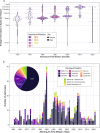Astronaut omics and the impact of space on the human body at scale
- PMID: 38862505
- PMCID: PMC11166943
- DOI: 10.1038/s41467-024-47237-0
Astronaut omics and the impact of space on the human body at scale
Abstract
Future multi-year crewed planetary missions will motivate advances in aerospace nutrition and telehealth. On Earth, the Human Cell Atlas project aims to spatially map all cell types in the human body. Here, we propose that a parallel Human Cell Space Atlas could serve as an openly available, global resource for space life science research. As humanity becomes increasingly spacefaring, high-resolution omics on orbit could permit an advent of precision spaceflight healthcare. Alongside the scientific potential, we consider the complex ethical, cultural, and legal challenges intrinsic to the human space omics discipline, and how philosophical frameworks may benefit from international perspectives.
© 2024. The Author(s).
Conflict of interest statement
D.B. is Co-founder of Poppy Health, Inc. and CSO of Yuri Gravity GmbH; C.E.M is Co-Founder of Onegevity Health; S.G. is scientific advisor to 10x Genomics, which holds IP right to the ST technology, and holds stocks. The remaining authors declare no competing interests.
Figures



References
-
- Mason, C. E. TheNext 500 Years: Engineering Life to Reach New Worlds. (MIT Press, 2021).
-
- Da Silveira W. A. et al. Revamping Space-omics in Europe. Cell Syst. 11, 555–556 (2020). - PubMed
Publication types
MeSH terms
Grants and funding
LinkOut - more resources
Full Text Sources
Research Materials

